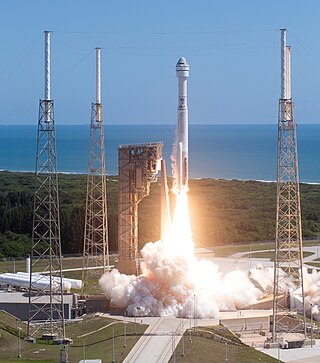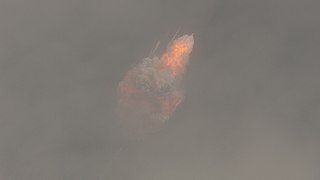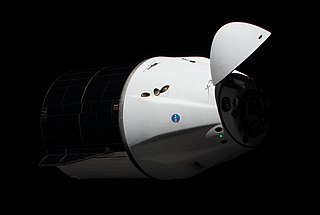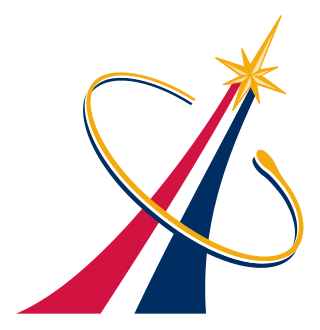
Dragon is a family of spacecraft developed and produced by American private space transportation company SpaceX.

The Boeing Starliner is a spacecraft designed to transport crew to and from the International Space Station (ISS) and other low-Earth-orbit destinations. Developed by Boeing under NASA's Commercial Crew Program (CCP), it consists of a reusable crew capsule and an expendable service module.

Development of the Commercial Crew Program (CCDev) began in the second round of the program, which was rescoped from a smaller technology development program for human spaceflight to a competitive development program that would produce the spacecraft to be used to provide crew transportation services to and from the International Space Station (ISS). To implement the program, NASA awarded a series of competitive fixed-price contracts to private vendors starting in 2011. Operational contracts to fly astronauts were awarded in September 2014 to SpaceX and Boeing, and NASA expected each company to complete development and achieve crew rating in 2017. Each company performed an uncrewed orbital test flight in 2019.

SpaceX CRS-2, also known as SpX-2, was the fourth flight for SpaceX's uncrewed Dragon cargo spacecraft, the fifth and final flight for the company's two-stage Falcon 9 v1.0 launch vehicle, and the second SpaceX operational mission contracted to NASA under a Commercial Resupply Services (CRS-1) contract.

Dragon 2 is a class of partially reusable spacecraft developed, manufactured, and operated by American space company SpaceX for flights to the International Space Station (ISS) and private spaceflight missions. The spacecraft, which consists of a reusable space capsule and an expendable trunk module, has two variants: the 4-person Crew Dragon and Cargo Dragon, a replacement for the Dragon 1 cargo capsule. The spacecraft launches atop a Falcon 9 Block 5 rocket, and the capsule returns to Earth through splashdown. Since 2020, when Dragon 2 flew its first crewed and uncrewed flights, it has proven to be the most cost-effective spacecraft ever used by NASA.

Crew Dragon Demo-1 was the first orbital test of the Dragon 2 spacecraft. The mission launched on 2 March 2019 at 07:49:03 UTC, and arrived at the International Space Station on 3 March 2019, a little over 24 hours after the launch. The mission ended with a splashdown on 8 March 2019 at 13:45:08 UTC.

Crew Dragon Demo-2 was the first crewed test flight of the Crew Dragon spacecraft. The spacecraft, named Endeavour, launched on 30 May 2020 on a Falcon 9 rocket, and carried NASA astronauts Doug Hurley and Bob Behnken to the International Space Station in the first crewed orbital spaceflight launched from the United States since the final Space Shuttle mission in 2011, and the first ever operated by a commercial provider. Demo-2 was also the first two-person orbital spaceflight launched from the United States since STS-4 in 1982. Demo-2 completed the validation of crewed spaceflight operations using SpaceX hardware and received human-rating certification for the spacecraft, including astronaut testing of Crew Dragon capabilities on orbit.

The Boeing Starliner Orbital Flight Test was the first orbital mission of the CST-100 Starliner spacecraft, conducted by Boeing as part of NASA's Commercial Crew Program. The mission was planned to be an eight-day test flight of the spacecraft, involving a rendezvous and docking with the International Space Station (ISS), and a landing in the western United States. The mission was launched on December 20, 2019 at 11:36:43 UTC or 06:36:43 AM EST; however an issue with the spacecraft's Mission Elapsed Time (MET) clock occurred 31 minutes into flight. This anomaly caused the spacecraft to burn into an incorrect orbit, preventing a rendezvous with the International Space Station (ISS). The mission was reduced to just two days, with the spacecraft successfully landing at White Sands Space Harbor on December 22, 2019.

Boeing Crew Flight Test (Boe-CFT) was the first crewed mission of the Boeing Starliner capsule. Launched on 5 June 2024, the mission flew a crew of two NASA astronauts, Barry E. Wilmore and Sunita Williams, from Cape Canaveral Space Force Station to the International Space Station. The mission was meant to last eight days, ending on 14 June with a landing in the American Southwest. However, the capsule's thrusters malfunctioned as Starliner approached the ISS. After more than two months of investigation, NASA decided it was too risky to return Wilmore and Williams to Earth aboard Starliner. Instead, the Boeing spacecraft returned uncrewed on 7 September 2024, and the astronauts will ride down on the SpaceX Crew-9 spacecraft in February 2025.

SpaceX Dragon 1 was a class of fourteen partially reusable cargo spacecraft developed by SpaceX, an American private space transportation company. The spacecraft flew 23 missions between 2010 and 2020. Dragon was launched into orbit by the company's Falcon 9 launch vehicle to resupply the International Space Station (ISS). It was succeeded by the Dragon 2 spacecraft which has both crewed and cargo versions.

SpaceX Crew-1 was the first operational crewed flight of a Crew Dragon spacecraft, and the maiden flight of the Crew Dragon Resilience spacecraft. It was also the second crewed orbital flight launch by the United States since that of STS-135 in July 2011. Resilience launched on 16 November 2020 at 00:27:17 UTC on a Falcon 9 from Kennedy Space Center Launch Complex 39A (LC-39A), carrying NASA astronauts Michael Hopkins, Victor Glover and Shannon Walker, along with JAXA astronaut Soichi Noguchi, all members of the Expedition 64 crew. The mission was the second overall crewed orbital flight of the Crew Dragon.

The Crew Dragon In-Flight Abort Test was a successful test of the SpaceX Dragon 2 abort system, conducted on 19 January 2020. It was the final assessment for the Crew Dragon capsule and Falcon 9 launch system before they would be certified to carry humans into space. Booster B1046.4 and an uncrewed capsule C205 were launched from Launch Complex 39A (LC-39A) on a suborbital trajectory, followed by an in-flight abort of the capsule at max Q and supersonic speed. The test was carried out successfully: the capsule pulled itself away from the booster after launch control commanded the abort, and landed safely.

SpaceX CRS-22, also known as SpX-22, was a Commercial Resupply Services (CRS) mission to the International Space Station (ISS) that launched at 17:29:15 UTC on 3 June 2021. The mission is contracted by NASA and is flown by SpaceX using a Cargo Dragon 2. This is the second flight for SpaceX under NASA's CRS Phase 2 contract awarded in January 2016.

The Boeing Orbital Flight Test-2 was a repeat of Boeing's unsuccessful first Orbital Flight Test (Boe-OFT) of its Starliner spacecraft. The uncrewed mission was part of NASA's Commercial Crew Program. OFT-2, using Starliner Spacecraft 2, launched 19 May 2022 and lasted 6 days. Starliner successfully docked with the International Space Station (ISS) on 21 May 2022. It stayed at the ISS for 4 days before undocking and landing in the White Sands Missile Range on 25 May 2022.

The Commercial Crew Program (CCP) provides commercially operated crew transportation service to and from the International Space Station (ISS) under contract to NASA, conducting crew rotations between the expeditions of the International Space Station program. American space manufacturer SpaceX began providing service in 2020, using the Crew Dragon spacecraft, and NASA plans to add Boeing when its Boeing Starliner spacecraft becomes operational no earlier than 2025. NASA has contracted for six operational missions from Boeing and fourteen from SpaceX, ensuring sufficient support for ISS through 2030.

Crew Dragon Resilience is the second operational Crew Dragon reusable spacecraft manufactured and operated by SpaceX. It first launched on 16 November 2020 to the International Space Station (ISS) on the SpaceX Crew-1 mission, the first operational flight of NASA's Commercial Crew Program. It was subsequently used for Inspiration4 in 2021, the first private spaceflight mission with an all-civilian crew, and the Polaris Dawn mission in September 2024.

Crew Dragon Endeavour is the first operational Crew Dragon reusable spacecraft manufactured and operated by SpaceX. It first launched on 30 May 2020 to the International Space Station (ISS) on the Crew Dragon Demo-2 mission. It has subsequently been used for the SpaceX Crew-2 mission that launched in April 2021, the private Axiom Mission 1 that launched in April 2022, and the SpaceX Crew-6 mission that launched in March 2023. It is currently in orbit after launching the SpaceX Crew-8 mission in March 2024. The capsule was named after Space ShuttleEndeavour. As of August 2024, Endeavour holds the record for the most time in orbit by a crewed spacecraft.

SpaceX Crew-2 was the second operational flight of a Crew Dragon spacecraft, and the third overall crewed orbital flight of the Commercial Crew Program. The mission was launched on 23 April 2021 at 09:49:02 UTC, and docked to the International Space Station on 24 April at 09:08 UTC.

The Crew Dragon Pad Abort Test was a spacecraft test conducted by SpaceX on 6 May 2015 from the Space Launch Complex 40 (SLC-40) at Cape Canaveral Air Force Station, Florida. As part of the development of NASA's Commercial Crew Program, the test demonstrated the spacecraft's abort system capability, verifying the capsule's eight side-mounted SuperDraco thrusters' capability to quickly power itself away from a failing rocket while it is still on the ground. It was one of the two tests conducted by SpaceX on the abort system of spacecraft, the other one being the Crew Dragon In-Flight Abort Test conducted on 19 January 2020.

Crew Dragon C205 is a Crew Dragon capsule manufactured and built by SpaceX. It completed its only flight on January 19, 2020, with the Crew Dragon In-Flight Abort Test mission where the capsule detached from the Falcon 9 B1046 booster at max q using the SuperDraco abort thrusters. This was done to test the functionality of the abort thrusters in an operational rocket launch.





















